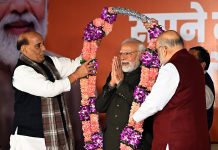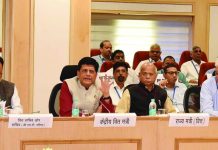 As the country reels under the shock of multiple bank frauds and thepotential impact of lakhs of crores of bad loans in the banking system, the All India Bank Officers’ Confederation (AIBOC) has asked the government to stop the blame game in bank frauds and instead make the Reserve Bank of India (RBI) take responsibility for introducing new systems and for failure in bank supervision.
As the country reels under the shock of multiple bank frauds and thepotential impact of lakhs of crores of bad loans in the banking system, the All India Bank Officers’ Confederation (AIBOC) has asked the government to stop the blame game in bank frauds and instead make the Reserve Bank of India (RBI) take responsibility for introducing new systems and for failure in bank supervision.
Regulatory agencies, including the central bank, need to become more vigilant and the role of auditors needs to be probed further. Banks are already being audited multiple times and, hence, there is need for a regulatory agency to make sure that auditors are playing their due role. As the Nirav Modi-Punjab National Bank (PNB) scam unfolds, it is clear that those who were to monitor transactions failed at their job.
It must be recalled that one of the fallouts of the scandal surrounding the US energy company Enron was the closure of reputed accounting firm Arthur Andersen. In our country too, stern action must be taken against auditing agencies. At the same time, greater autonomy needs to be given to state-run banks. The issue of appointments of bank chiefs, for instance, is a key issue meant to be handled by the relatively new Banks Board Bureau. Instead, it seems to remain within the purview of the Finance Ministry. All these issues will now have to be reviewed and overhauled in light of the worsening news from banks.
The Bank Officers Confederation had earlier objected to banks being burdened with the responsibility of Aadhaar enrolment, which is now a bigger and more dangerous issue given the impunity with which bank officials have participated in fraud. However, the Bank Officers Confederation has a different take and makes some important points about the accountability of regulators and the government.
DT Franco, General Secretary of AIBOC, said, “Much is talked and written about scams in the banking sector after the Nirav Modi scam in Punjab National Bank (PNB). Why do the RBI, Finance Ministry, Central Vigilance Commission (CVC) and others wake up only when a major scam surfaces? Why are we not analyzing the failure of the system? What is the role of the Government and its policies which cause system failures and scams?” There have been infamous scams such as those pertaining to Harshad Mehta, Ketan Parekh and the non-performing asset (NPA) scam, which have not yet been declared as ‘scams’ by the Government or the RBI due to misuse of the loopholes in the system. „In India, the political economy circumscribes the quality of regulation and internal control policies at banks. It is important to appreciate this while fixing responsibility for the bad loans and large frauds at public sector banks (PSBs),“ observed the AIBOC .
About the misuse of letters of undertaking (LoU) in the recent Nirav Modi fraud case, Franco said, „In this case, when a buyer’s credit is available for importers, then why did the RBI introduce LoUs, which is not in vogue among foreign banks? What was the necessity for RBI to encourage imports by helping the borrower to get cheaper credit abroad instead of helping Indian Banks to increase them credits that would give better taxes for the country? It is a well-known fact that the SWIFT has been used for frauds from the nineties and there are many reported hacks of SWIFT. Why did the RBI and the Government not intervene to correct the system? What happened to supervision and audit? Why did the RBI failed in supervision? Is it because the RBI has been busy with other things like demonetisation? They are still counting the notes even after a year! Has RBI lost its autonomy?” The bank officers also raised several questions on transfer and appointment of another person as Managing Director at PNB, while it is the job of the Banking Board’s Bureau headed by Vinod Rai to make such appointments.
Explaining reasons for weak supervision in banks, AIBOC said, “Why are banks forced into other activities like Aadhaar linkage, Aadhaar enrolment, selling pension scheme of the Government and cross-selling. These are major reasons for weakening supervision. Why is the RBI still hesitant to publish list of defaulters and thus allowing them to run away from the country. Why does the Prime Minister take with him on foreign tours businessmen who are known for misuse of the system? Why do the same set of businessmen get contracts abroad? Why are these businessmen showcased abroad and why are they selected by the Prime Minister’s Officer (PMO) and Finance Ministry instead of industry associations, which was the practise earlier?”
Accordion to AIBOC, only 11,643 borrowers in the country have availed 38 per cent of the total loans given by banking sector as on March 2016. Just 12 NPA accounts have an outstanding of 2.50 lakh crore and 84 per cent of the NPAs belong to corporates. Every year banks writeoff thousands of crores for there corporates, which is the biggest scam. The Federation of Indian Chambers of Commerce and Industry (FICCI) and the Associations of Chambers of Commerce of India (Assocham) should ask their members to be honest and repay the loans instead of demanding privatisation.”
Blaming the RBI for not publishing list of NPA borrowers and introducing new mechanism to help corporates, the bank officers’ union says, “The RBI is the one which introduced Corporate Debt Restructuring (CDR), Strategic Debt Restructuring (SDR), Sustainable Structuring of Stressed Assets or S4A, asset quality review (AQR) and Prompt Corrective Action (PCA). None of them have helped the banks but they have helped the corporates to loot. With the revised norms the banks will have to declare 2 lakh crore more as NPAs and provide 50 per cent provision for them. This is going to make all the banks in the country to become red. This will lead to a financial crisis like the US crisis of 2008. The Government may announce a financial emergency and handover banks to the corporates. This will be a danger to democracy itself.”
“Despite a sticky systemic NPA issue with PSB for five years, we have had no run on a bank, no stress in
the money markets and limited impact on growth. While there are many reasons for this, a big reason has been state ownership of the banking system. It has meant that bank liabilities have implicit sovereign guarantee, which maintained confidence of the markets in the banking system,” it added.
Privatisation opposed
Opposing the talk about privatisation of PSBs, the bank officers confederation says, “We need better banking, better reporting, better supervision and better technology in aid of these. What we need is to ignore the cry to privatise PSBs, as if ownership uniquely determines ethics and efficiency. The popular chestnut is that PSBs are structurally vulnerable to poor governance, resulting in the run-up inNPAs. Data, yet again, militate against the hypothesis. While theremight be cases of fraudulent behaviour, they are not the overwhelmingcause for the accretion of NPAs in PSB. Second, cases of governancebreakdowns are not a monopoly of PSB — globally and in India, manyprivately-owned banks have been regularly identified with such errors of omission and commissions. Global regulatory fines on banks run into many billions of dollars every year.”
The Economic Survey 2016-17 studied the causes of the large NPA build-up in PSB. A very large part of it can be attributed to a growth—induced credit bubble, followed by macroeconomic and regulatory issues that burst the bubble rudely. Corruption and malfeasance were not identified as a key variable. In 2008, a raft of European and American banks, all privately owned, had to be bailed out by governments. The list of institutions bailed out included some of the best known brands in the business. The financial crisis of 2007-08 was the result not of public sector sloth and corruption but of private sector greed and poor regulation. Lehman Brothers went belly up, without any state ownership. Royal Bank of Scotland and Barclays avoided collapse by taking government equity.
“It is not ownership but the quality of regulation, reporting andmanagement that determine banking efficiency. Closer home,privately-owned Global Trust Bank and Bank of Rajasthan had to berescued with state support. The reason for the above is quite simple — banking isn’t the same as soaps, or steel, or hotels,” the bankofficers’ confederation said. According to AIBOC, banking bailouts inIndia have been quite modest in terms of their impact, both in termsof direct fiscal costs as well as indirect costs to the economy. AnIMF Working Paper on Systemic Banking Crisis, covering all banking andsovereign crises between 1970 and 2011, brings out the data starkly.
The average fiscal cost of bank bailouts across the world was 6.8 per cent of GDP between 1970 and 2011. For emerging economies, the cost was 10 per cent of GDP. For India, in the same period, bank bailouts cost far less than 1 per cent of GDP, a negligible amount. “The current PSB recapitalisation plan announced by the government, amounting to Rs 2.11 lakh crore over two years, would account for less than 0.5 per cent of current year GDP, and less than 0.25 per cent annualised for two years. Further, India’s bank bailouts have extracted far less cost out of the Indian economy than bank stress situations elsewhere,” AIBOC added.
Those who insist on privatisation of public sector banks opine that bank operations are overly controlled by the government, leading to their manipulation by powerful political lobbies. Public sector banks are indeed vulnerable to pulls and pressures from the government and tempted by manipulative corporates. These may have created many lacunas in the banking system which can be exploited by some greedy businessmen in connivance with a handful of corrupt bankers. But these fractures in the structures of public sector banks need to be repaired rather than resorting to privatisation.
The recession was primarily the result of the international financial institutions which failed and at the time were in the private sector. This includes the iconic Lehman Brothers and Bear Stearns which collapsed while others like Merrill Lynch, AIG, and the mortgage lending institutions, Fannie Mae and Freddie Mac, had to be rescued by the state. Apart from the 2008 financial crisis, there have been many instances of bank frauds leading to closures such as Barings Bank which had to down shutters due to the activity of a single rogue trader. Officials of Barclays Bank of the UK are reported to be only now facing fraud charges over activities carried out in 2008. The private sector banks or the new generation banks are certainly not the holy cows immune to the same problems that plague the public sector entities. Private banks, too, have their share of bad loans.
The recent half-year financial stability report by the RBI noted that the rate of increase of NPAs was 40.8 per cent for private sector banks as against 17 per cent for public sector banks on a year-on-year basis in September 2017. It also disclosed that all top private sector lenders, including ICICI Bank, Axis Bank, Yes Bank and HDFC Bank, had under-reported their dud assets in the first two quarters of the fiscal. In other words, the private banks renowned for their speed and efficiency in contrast to the tortoise-like pace of the state-owned banks are in the grip of the same malaise of mounting bad loans as the latter.
What the Govt needs to do
Privatisation, then, is not the over-arching solution to all the woes facing the government-owned bank industry. It is undoubtedly true that a major restructuring is needed in the operations and performance levels of these banks. The government needs to take up the issue of reviving the banking sector in all seriousness. Privatisation is surely not the way forward. But steps to improve governance standards need to be taken immediately to cleanse and revive this crucial sector of the economy.
Why PSB’s?
It is worth mentioning that ever since the Indian government nationalised the Imperial Bank of India in 1955 and re-christened it State Bank of India, public sector banks (PSBs) have continued to be of immense systemic importance. This was further reinforced during the nationalisation of banks in 1969 and again in 1980.
Today, despite their shrinking market share, PSBs continue to be very important for the economy, particularly one like India. With their widespread and far-reaching network, PSBs are the only source of financial connectivity for large swathes of the population, mobilising deposits as well as providing credit for productive sectors. These banks have been the backbone of the financial social agenda for the government, including being the frontrunners of the Jan Dhan Yojana.
In any particular rural area, the role of a PSB is not confined to banking but encompasses a more holistic developmental agenda. They are the one-stop shop for all financial needs of the local rural populace including insurance, financial literacy, remittance amongst others.
The strong uptake of payment banks licence indicates the vast unmet demand that still exists in India’s rural areas and provides a significant opportunity for PSBs to capture this. Clearly, the importance of PSBs in India even today cannot be belittled. The Indian economy needs a strong banking system to continue and expand on the current growth trajectory and the PSBs play a significant role in this. As the bulwark of financial services available to India’s rural masses, PSBs form the backbone of the growth emanating from India’s villages.
letters@tehelka.com












